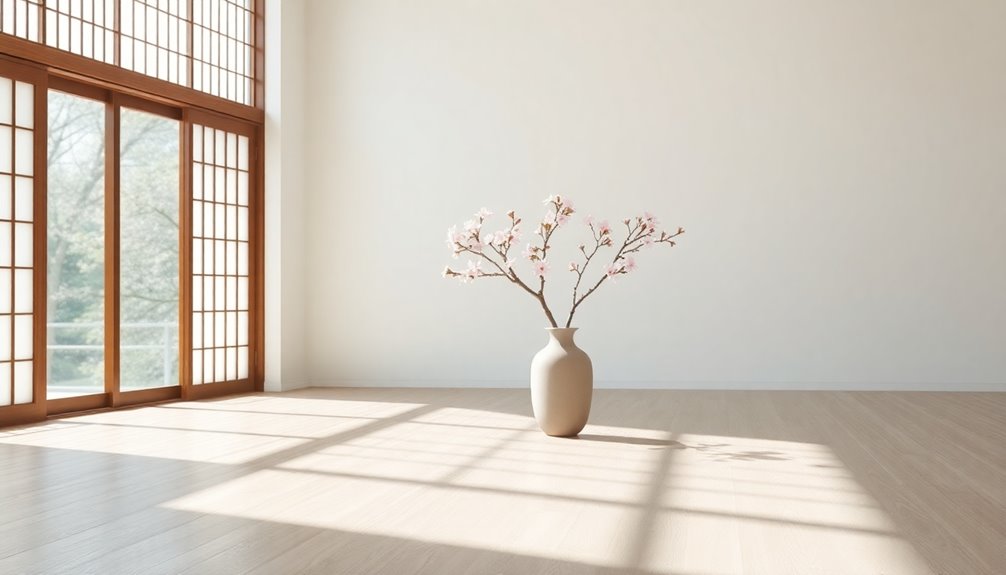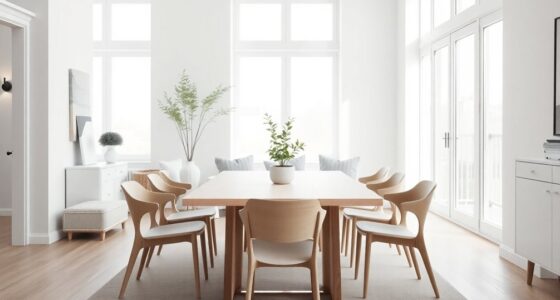Japanese minimalism has influenced global design by emphasizing simplicity, sustainability, and mindfulness. Concepts like Wabi-Sabi and Danshari encourage you to appreciate beauty in imperfection and declutter your life, while natural materials and neutral color palettes enhance tranquility. You'll see this impact in architecture, fashion, and product design, where functionality and quality take precedence. This philosophy resonates with your desire for intentional living and a closer connection to nature. There's much more to discover about its broader implications.
Key Takeaways
- Japanese minimalism emphasizes simplicity and functionality, influencing global design trends towards cleaner lines and less cluttered spaces.
- The principles of Wabi-Sabi and Ma inspire designers to embrace imperfection and negative space in various art forms worldwide.
- Sustainable practices rooted in Japanese minimalism, such as using natural materials, have gained traction among global designers prioritizing eco-friendly choices.
- The aesthetic of Zen has led to the incorporation of serene environments in global architecture, promoting mindfulness and tranquility in design.
- Minimalist fashion influenced by Japanese principles encourages timeless, versatile clothing, impacting global retail and consumer behavior towards conscious consumption.
Philosophical Foundations of Japanese Minimalism
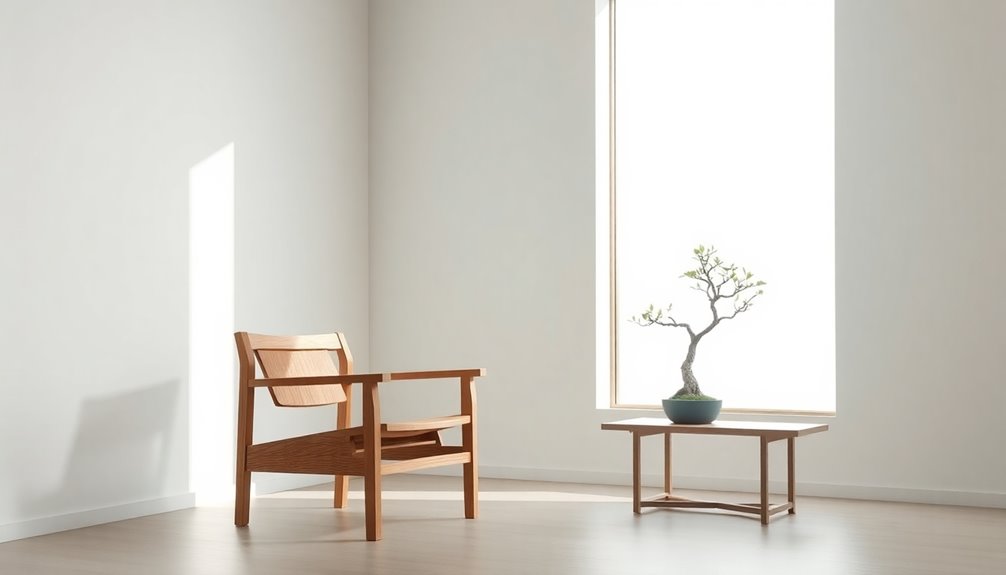
While many design philosophies focus on excess, Japanese minimalism invites you to embrace simplicity through its rich philosophical foundations.
Central to this approach is Wabi-Sabi, which teaches you to find beauty in imperfection and the transient nature of life.
Embrace the beauty of imperfection and the fleeting moments that life offers through the philosophy of Wabi-Sabi.
You'll also discover the concept of Ma (間), emphasizing the importance of negative space and spatial harmony.
Danshari encourages you to declutter both your physical and mental spaces, promoting a lifestyle that values simplicity and intentionality.
By eliminating unnecessary elements, traditional Zen aesthetics create serene environments that foster mindfulness and tranquility.
Incorporating natural materials like wood, stone, and bamboo deepens your connection to nature, reflecting sustainability and enhancing your overall well-being in a balanced relationship with your surroundings. Emotional regulation is also fostered through minimalistic design, as the simplicity can help reduce stress and promote mental clarity.
Japanese Minimalism in Architecture
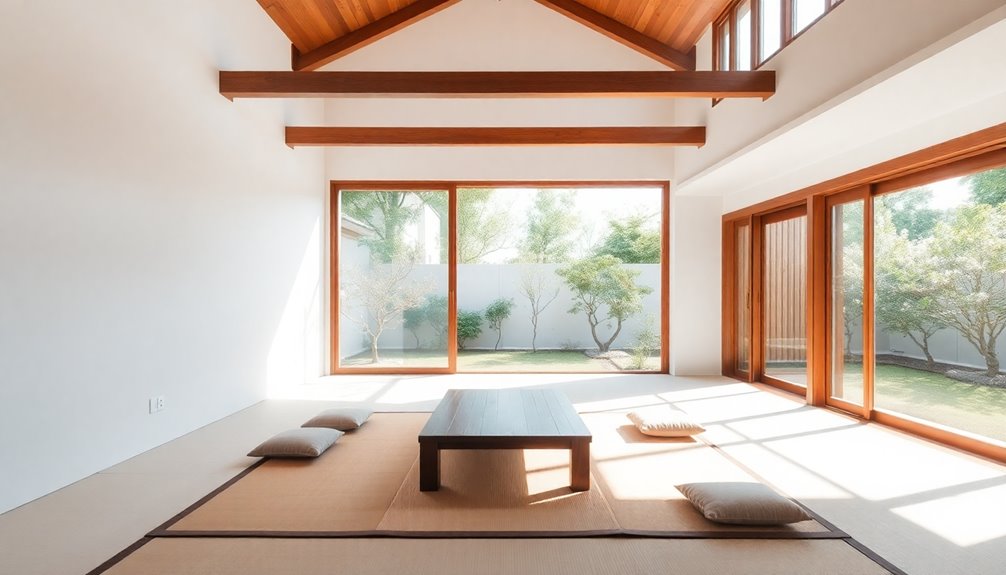
How does Japanese minimalism in architecture transform our understanding of space? It invites you to appreciate simplicity and functionality through Japanese minimalist design. By focusing on clean lines and natural materials, you experience harmony and a connection to the outdoors.
Here are key elements that define this architectural style:
- Natural Light: Maximizing daylight to enhance mood and perception of space.
- Open Floor Plans: Creating fluid shifts that promote movement and interaction.
- Traditional Elements: Using shoji and engawa to blur indoor and outdoor boundaries.
- Aging Techniques: Celebrating the beauty of materials through Sho Sugi Ban and Kintsugi.
This approach fosters wellness-oriented design, emphasizing serenity and mindful living, shaping architecture worldwide. Additionally, the principles of energy efficiency in design can also be incorporated to create sustainable and eco-friendly spaces.
Minimalism in Interior Design

Japanese minimalism in interior design transforms your living space into a sanctuary of peace and simplicity. Emphasizing open floor plans, it seamlessly integrates indoor and outdoor spaces, maximizing natural light and fostering tranquility.
By using natural materials like wood, stone, and bamboo, you create a strong connection to nature while promoting sustainability. Decluttering is essential, as it focuses on essential and functional elements that encourage intentional living and reduce visual noise.
Employing neutral color palettes of whites, beiges, and muted earth tones evokes calmness and serenity. As global design trends increasingly adopt these principles, the incorporation of indoor plants can further enhance your home, reflecting a contemporary approach to wellness-oriented living spaces that prioritize simplicity and mindfulness, enhancing your overall quality of life.
Minimalism in Fashion
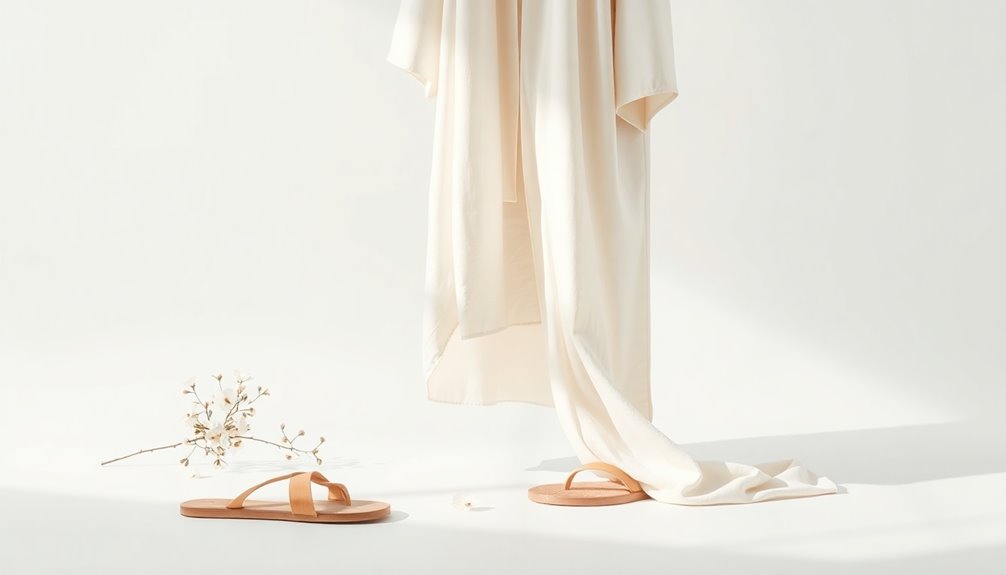
When you think about Japanese minimalism in fashion, you can't help but notice its focus on sustainable choices and timeless designs. These elements not only create versatile wardrobes but also set a standard influencing global trends. Additionally, the emphasis on sustainable choices in minimalism aligns with the growing consumer demand for ethical fashion practices.
Sustainable Fashion Choices
Embracing sustainable fashion choices means considering the impact of what you wear on the planet.
By adopting a minimalist aesthetic, you can make a significant difference in your wardrobe.
Here are four ways to prioritize sustainable living:
- Choose quality over quantity: Invest in timeless pieces that last longer and resist trends.
- Select multi-functional garments: Look for versatile items that can be styled in various ways, reducing the need for excess.
- Support ethical brands: Opt for companies that use eco-friendly materials and sustainable production practices, like Muji.
- Practice mindful consumption: Reflect on your purchases and their environmental impact, ensuring each item adds value to your life.
Incorporating eco-friendly options into your wardrobe choices not only elevates your style but also contributes to a healthier planet.
Timeless Design Elements
Minimalism in fashion is all about timeless design elements that prioritize simplicity and functionality.
The timeless appeal of Japanese minimalism lies in its simple silhouettes and clean, geometric lines, showcasing the beauty of understated design. By embracing minimalist principles, you can create versatile outfits that transcend seasonal trends.
Neutral and muted tones dominate these collections, allowing for easy styling and adaptability. Additionally, the focus on natural materials reinforces a commitment to quality over quantity, encouraging you to make mindful fashion choices.
Brands like Muji exemplify this approach, offering functional and stylish pieces that resonate with your desire for comfort and usability. This philosophy aligns with the concept of astrological compatibility, as individuals may find that their personal style reflects their inherent traits and preferences.
Ultimately, Japanese minimalism invites you to invest in enduring designs that enhance your wardrobe sustainably.
Influence on Global Trends
Japanese minimalism has shaped global fashion trends by championing simplicity and functionality, influencing countless designers worldwide. This movement emphasizes simplicity in design, leading to a shift in how you approach fashion.
Here are four key elements driving this global movement toward minimalism:
- Simple Silhouettes: Clean, geometric lines that enhance elegance.
- Neutral Tones: Designers like Issey Miyake and Yohji Yamamoto favor muted colors, reflecting understated beauty.
- Sustainable Practices: A focus on ethical production encourages timeless, versatile garments that resist fast fashion.
- Conscious Consumption: The 'less is more' philosophy urges you to invest in meaningful pieces.
Additionally, the principles of emotional regulation found in various therapeutic approaches can parallel the intentional mindfulness embraced in minimalist fashion.
Embracing these principles allows you to align with the emphasis on simplicity that Japanese minimalism promotes in today's fashion landscape.
Impact on Digital and Product Design

As you explore the domain of digital and product design, you'll notice how the influence of Japanese aesthetics promotes a focus on clean interfaces and intuitive navigation. This emphasis enhances user experience by creating visually calming environments that prioritize content.
Brands like Muji exemplify the principles of simplicity, functionality, and versatility, driving a global trend toward aesthetically pleasing, user-centered products. Minimalist web design often employs neutral color palettes and geometric shapes, fostering a sense of peace.
Additionally, Japanese minimalism encourages the use of natural materials, aligning with consumers' desires for quality and intentionality. This approach not only elevates design but also nurtures a culture of mindfulness, resonating deeply with users who seek simplicity in their everyday lives. The growing interest in AI-driven solutions further supports this minimalistic approach in design, as technology seeks to streamline processes and enhance user interactions.
Sustainability and Mindful Living
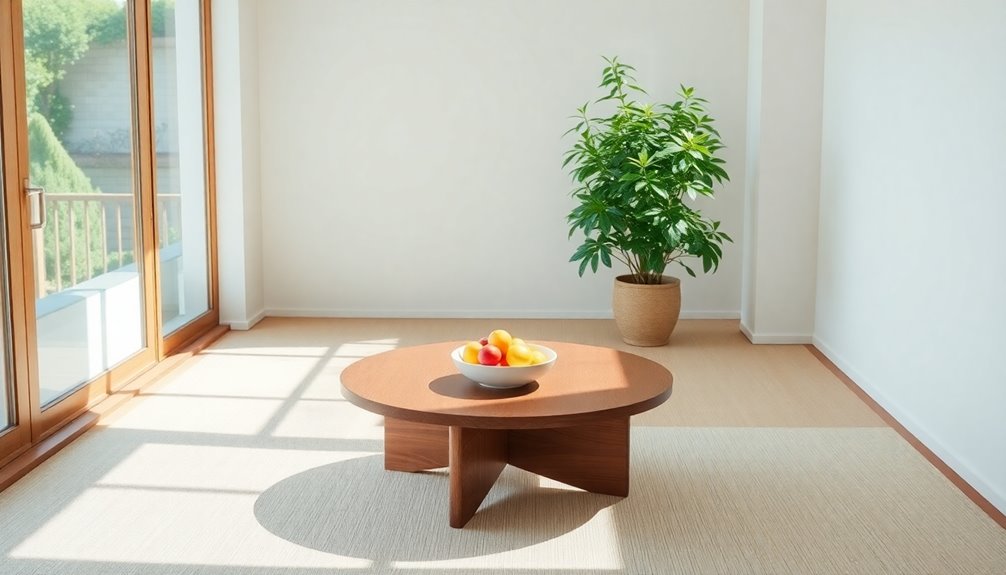
Embracing a lifestyle rooted in sustainability and mindful living can transform how you interact with the world around you.
A sustainable and mindful lifestyle can profoundly change your relationship with the world.
By adopting principles from Japanese minimalism, you can enhance your well-being and reduce your environmental impact.
Consider these key practices:
- Choose natural materials like wood, stone, and bamboo for your home and belongings.
- Practice Danshari by decluttering and focusing on quality over quantity.
- Explore brands like Muji that prioritize functionality and sustainability in design.
- Embrace tiny living spaces that promote conscious consumption and minimize waste.
- Adopting a diet rich in raw foods can further support your commitment to health and sustainability.
Frequently Asked Questions
How Can I Start Practicing Japanese Minimalism in My Daily Life?
You can start practicing Japanese minimalism by decluttering your space.
Begin with one room and remove items that don't bring you joy or serve a purpose. Simplify your belongings by choosing quality over quantity.
Incorporate natural materials and neutral colors to create a calming atmosphere. Limit distractions by reducing digital clutter, too.
Designate a few moments each day for mindfulness, allowing yourself to appreciate simplicity in your surroundings and daily routine.
What Are Some Common Misconceptions About Japanese Minimalism?
Many people think minimalism means living with almost nothing, but that's not true.
In fact, studies show that 35% of individuals practicing minimalism still own cherished items that bring them joy. You might believe it's about strict rules, but it's more about intentionality in what you keep.
Another misconception is that it's only for certain lifestyles; in reality, anyone can embrace minimalism, regardless of their circumstances or preferences.
It's about simplicity, not deprivation.
Are There Specific Materials Used in Japanese Minimalist Design?
In Japanese minimalist design, you'll often find specific materials that enhance simplicity and functionality.
Wood, particularly light woods like cedar and pine, creates warmth, while stone and clay add a natural element.
Paper, especially washi, is used in screens and partitions, promoting lightness and texture.
Metals, like stainless steel, contribute to a sleek look.
How Does Japanese Minimalism Influence Contemporary Art?
Japanese minimalism influences contemporary art by encouraging you to embrace simplicity and focus on essential elements.
When you engage with artworks inspired by this style, you'll notice a preference for open spaces, clean lines, and a restricted color palette.
This approach invites you to experience the beauty of the ordinary and invites reflection.
What Are the Key Differences Between Japanese and Western Minimalism?
When you compare Japanese and Western minimalism, you'll notice a few key differences.
Japanese minimalism often emphasizes nature, tranquility, and harmony, reflecting a deep connection to the environment. In contrast, Western minimalism tends to focus on form, function, and a more industrial aesthetic.
While both appreciate simplicity, Japanese design often incorporates organic materials and subtle textures, whereas Western approaches might prioritize stark, geometric lines and bold contrasts.
Each style offers a unique perspective on minimalism.
Conclusion
Japanese minimalism is like a calming breeze, sweeping away the clutter of modern life. Its elegant simplicity inspires global design across architecture, interiors, fashion, and digital products, encouraging you to embrace sustainability and mindful living. As you incorporate these principles into your own space, remember that less truly can be more, inviting clarity and tranquility into your daily routine. Through this minimalist lens, you can create a world that's not just beautiful, but also meaningful.
